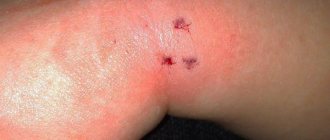What fleas live on animals
There are a huge number of varieties in nature. They can live on animals, humans and rodents. Each of them is adapted to a certain body temperature, blood and other characteristics of the victim’s body. In the absence of these, the insect can feel great on animals or people in close proximity.
On cats
Their variety: "Ctenocephalides felis". They can be red and brown. On the skin of an animal, they look like particles of dirt, only by their movement, you can understand that it is a flea. The eggs are white particles, similar to grains of rice, only smaller in size. But the female does not lay larvae directly in the fur; she chooses other places for this. This could be: carpeting, upholstery, cracks in the floor and under baseboards. The body has spines and bristles for deft movement along the hairs; the hind legs are shorter than the front ones. Can jump to a height of 1.5 meters.
Some people wonder whether cat fleas can spread to humans - they pass to people 3 times more often than dog fleas. It is also important to know that when bitten, the causative agent of the disease is transmitted to a new victim, if before that they fed on the blood of an infected animal.
On dogs
Their variety: "Ctenocephalides canis". They choose dogs, cats, horses. In times of famine, they will not refuse human blood. They have a flattened body, many bristles, and combs of flat teeth. They can live even in densely populated areas; they can survive without food for about 60 days. The dog flea bites humans and cats if there is no suitable victim nearby. The jump exceeds 4 times the length of the vision, she does not see where she wants to jump. Body length up to 5 mm. Color range: from yellow to dark brown. These parasites also pose a danger to humans in the form of infection with various diseases.
The process of transmission of fleas from pets to humans
In most cases, people are attacked by fleas that live in the fur of their pet. For example, a person can become infected with parasites from dogs directly in their home or the enclosure in which the pet lives. However, it is worth considering that fleas cannot live long on humans.
Typically, a flea bites a cat or dog, feeds on their blood, and then jumps off their body to find a secluded corner to lay eggs. Before the insect wants to eat again, it will live in the pet's bedding, in the carpet, in the trash, in cracks and corners of the room, where its offspring usually develop. When the flea gets hungry, it will again go in search of food. If a person is nearby, the insect will certainly attack him. That is why, when fleas get on people’s skin, they immediately bite them and begin to drink blood.
In very rare cases, fleas can jump from pets to humans right away. Here we are talking about a species of human fleas, for which humans are the optimal victim.
It is curious that dog fleas infect humans much less often than cat fleas. Felines, in turn, are the most common. They even attack people more often than the same human fleas.
To find prey, fleas rely on their sense of smell. It is certainly clear that the stronger a person smells, the faster the insect will detect him.
In those places where there are a lot of parasites, there will be a lot of hungry individuals. Accordingly, they will quickly jump on a person and begin to drink blood. For example, this often happens when a hunter finds himself next to a fox hole.
Can fleas be transmitted to humans?
In this case, the use of “transferred” is completely inappropriate; their presence on the body is short-term. That is, they just need to drink blood and change the body of the victim. This is precisely the goal pursued by blood-sucking insects; they have no other plans for “invasion” on people. Eggs are laid mainly in dark, damp and warm secluded places. If a flea is well-fed, it has no interest in the human body. Until her next appetite awakens, she will live in or near the trash can, on cat and dog supplies.
As soon as they feel signs of hunger, they will begin to attack everyone, indiscriminately. fleas spread to humans when they are present in dangerous places, these include doghouses, pet bedding, basements, and rooms with unsanitary conditions.
Are fleas transmitted from animals to people or not?
Are animal fleas transmitted to humans? In fact, this opinion is wrong. If you keep a cat at home, you should not be afraid or worry about being infected. Bloodsuckers do not regard humans as potential carriers. To procreate, insects need suitable conditions; here preference is given to dark, warm, humid places.
Are cat fleas transmitted to people?
By coincidence, people can only be an intermediate host of the parasite and perform a transit function. However, they are capable of attacking and biting at certain intervals in order to satisfy hunger. The most common ones that cause a lot of trouble are cat and dog fleas. To prevent the massive growth of huge colonies, active control measures should be taken immediately. This applies not only to disinfestation of the premises, but also to kill fleas in cats.
It is worth noting that each individual species is demanding on the characteristics of the temperature environment, the host’s skin, and blood. For example, in cats, the body temperature fluctuates between 37-39 °C; only heat-loving specimens choose them.
Chicken fleas are transmitted to humans
Chicken or bird fleas mainly parasitize mammals. Distinctive features of this species are a flat body 0.4 - 6 mm long, the presence of clawed paws designed for convenient attachment to the animal's fur. They also have a special proboscis for sucking blood. In addition, they prefer to feed on skin flakes and feather fragments.
These lice greatly weaken birds, causing itchy, uncomfortable bites. In addition, they transmit dangerous diseases and infections.
Most often, it is poultry farmers who fear the possibility of infection. But this insect will not remain on the body for long. There are rare cases when a bloodsucker bites; this usually happens when cleaning the inside of the chicken coop. If any individual lingers on your hair, it is very easy to get rid of it by taking a shower.
Are fleas transmitted from person to person?
Unlike cat fleas, human species are distinguished by their inactivity; they will not move long distances. But they spread very actively and are transmitted from one person to another. This happens by crawling or carrying with the help of personal hygiene items and household items (combs, hairpins, elastic bands, hats, scarves). Flea epidemics are inherent in crowded places; they spread extremely quickly in military barracks, camps, and communal apartments.
Symptoms of a flea bite
You can determine that this bite is a flea, and not another blood-sucking insect, by the following signs:
- pain and burning;
- they bite day and night, they do not have a specific time, unlike bedbugs;
- blisters on the damaged area;
- bites are located at a distance of 2 cm from each other;
- an allergic reaction is possible.
Fleas bite on any open area of the body. Often this is the neck, arms, legs, back (if the blood-sucking parasite has migrated to the bed, sofa, clothes).
Fleas in exotic countries: double danger
Exotic fleas pose an exotic danger to humans. Thus, sand fleas, widespread in the Caribbean, Vietnam and India, bite under the nails or simply into the skin, attach themselves to a blood vessel and significantly increase in size in a few days .
These are females in whose bodies the eggs mature. The cavity in which they find themselves during such parasitism becomes inflamed and causes acute pain to the person. Given that they most often infect the legs, their victims may even temporarily lose the ability to walk.
In advanced cases or with mass infection, a person may experience generalized inflammation and develop gangrene.
A small percentage of the population of these areas turns into disabled people precisely because of sand fleas.
The danger of fleas to humans
The danger depends on the type of blood-sucking parasite itself. If, for example, it previously fed on the blood of a sick animal, it may well infect a person through a bite. In medieval Europe, fleas were a sign of an outbreak of plague. Fortunately, no such epidemics have been identified so far. Dangerous diseases that blood-sucking parasites can infect: pulicosis - characterized by severe itching and redness of the skin, dermatitis - severe skin damage. In addition, they can easily infect various hepatitis viruses, typhoid, salmonellosis, and encephalitis. Also, these blood-sucking parasites are the main carriers of various worms, including helminths. If a flea gets into human food, it can lead to intestinal infections.
Danger for children
Regarding children, they are much more dangerous than for adults. This manifests itself in the fact that allergic reactions often occur, which are dangerous due to complications and concomitant diseases. The symptoms are more pronounced, the lymph nodes are enlarged. If a child has not been vaccinated, the risk increases several times. Because it is compulsory vaccination that protects against dangerous diseases.
Pregnant women should be careful. Although the danger is the same as that threatening adults, it is worth considering not only the state of health of the mother, but also the fetus. A banal allergic reaction can cause serious consequences. Do not forget about nervous disorders and stress, which are extremely undesirable.
Flea control
These parasites can be brought into your home after visiting an attic, basement, unsanitary room, and even after a walk. In order to prevent their appearance in the home and on animals, the following measures must be taken:
- When walking in the fresh air (in the park, in the local area, and wherever it may be), animals should wear special collars to repel blood-sucking parasites.
- Periodically wash and disinfect rugs and other pet supplies. Wash with bleach and other chlorine-containing products several times a month.
- Several times a week, and in the summer season, you can vacuum the upholstery of upholstered furniture, carpets, and rugs every day.
People who do not know that fleas are transmitted to humans should promptly treat their pets for blood-sucking parasites. But, if there are no dogs, cats or other living creatures in the house, it is necessary to treat the premises with disinfectants, since fleas can also be earthen fleas.
General rules for removing fleas from your apartment
The very first thing you should do is get rid of the insects that parasitize your pets. If you do not do this, then all your further work will not make any sense, since parasites multiply in the animal’s fur. To make sure of this, you can carefully examine your cat's fur by spreading it with your hands and you will see newly laid eggs and insect feces.
The photo shows flea bites.
Getting rid of fleas on pets is quite easy, since modern stores offer a wide range of insect removal products. If your animal is sick with something, then you can use anti-flea shampoo, which will not cause any harm to your pet. The main thing is to make sure that during bathing the foam does not get into your pet’s eyes or mouth. If the cat has a fairly weak immune system, chemicals entering the food tract can cause poisoning.
Prevention against fleas
No owner likes the appearance of blood-sucking parasites. Therefore, many are interested in the question: can fleas spread to humans.
To prevent infection, you must follow the recommendations below:
- After each walking of pets, they must be treated with special means. This includes shampoos and decoctions based on various plants, including wormwood.
- Use pine sawdust in bedding and other animal accessories. When you bathe your pet, wash with laundry soap.
- To avoid becoming infected with fleas from under a shaft or other premises with unsanitary conditions, treat it with chlorinated water or ammonia. Also, some owners recommend scattering wormwood bushes or sawdust in the corners.
Based on all of the above, one simple conclusion should be drawn: even if you put a rag soaked in a chlorinated solution on the threshold, this is also a preventative measure.
Allergy to a bite, consequences
The question of why fleas are dangerous does not have a clear answer. They are carriers of a variety of infectious diseases that lead to negative consequences for the body. These are plague, pulicosis, problems with the condition of the skin, and so on.
A child under 12 years of age may be allergic to flea bites. But adults often encounter this phenomenon. The main symptoms of allergic reactions to parasites are as follows:
- body temperature increases to forty degrees;
- anxiety arises, breathing becomes difficult;
- fever appears;
- stomach upset occurs.
Often, a person experiences anaphylactic shock caused by enzymes that are part of the flea's saliva. If this happens, you should immediately seek help from a doctor. The doctor will diagnose the body, take tests and tell you how to cope with the problem.
Reviews
Some people experience flea bites, and it is worth noting that only some of them suffer an allergic reaction. This is mainly due to diseases such as diabetes. People with this diagnosis are very sensitive to the bites of these blood-sucking parasites.
“I, Anna Nikolaenko, 59 years old, gardener. These “bloodsuckers” got the better of me when I moved to the dacha. I overcame them with the help of folk remedies. There was a lot of free space near the country house, so I decided to plant different flowers. But I don’t know exactly which one helped. I also read on the Internet and chose products based on people’s reviews.”
“I, Kristina Smirnova, 20 years old, live in the private sector. I want to tell my story. It happened like this: I was sitting on the couch, watching my favorite TV series, and felt a bite. I didn’t scratch it right away and decided to take a look. And there’s a black spot there, and it’s moving. I decided that I would catch it and crush it now. She jumped a few meters away from me and got scared herself. There were no more experiments, I decided to act quickly and sharply.”
This is just an excerpt from existing reviews; they can be found on forums and websites. After all, it is there that people share their folk recipes and how to prevent the appearance of fleas in a living room.
Watch the video - do fleas from animals live on people:
How does a flea develop?
There are very rare cases when a person becomes infected with insects from his pet, but such a development of events should in no case be excluded. Therefore, regularly take all measures to prevent the appearance of fleas in your pet's fur. To do this, just put an anti-flea collar on your dog while walking, and then you will not encounter this unpleasant problem.
The photo shows the consequences of flea parasitism.
Tip: the anti-flea collar is soaked in essential oils, which have a very pungent odor. In this regard, this remedy can be used as a preventive measure to prevent the problem of insects.
An insect does not always develop at the same time; this may depend on many factors. For example, if the temperature outside is quite cold for a long time, then the insect will mature much longer than in warm and sunny weather. Under favorable conditions, a flea is able to fully develop in two weeks and during this time it can already choose a victim for regular meals.
Immediately, as soon as the parasite is born, it begins to look for an object to obtain blood. Most often, pets become such objects, and it is best to immediately begin taking measures to remove insects, since after one flea appears in the pet’s fur, entire colonies will begin to form, which will be very difficult to get rid of.
Considering that insects require favorable conditions with high humidity to reproduce, this can be used against them. Experts very often recommend installing a special dryer in the bathroom, which must be turned on after taking a bath or shower. The device itself will remove all excess moisture that has accumulated over a certain amount of time.
Keep in mind that just because you brushed off an insect, this does not mean that the flea will soon die from lack of food. Parasites are able to survive without blood for about a year, during which time they almost always manage to find a new victim, which could well be you yourself.
The photo shows what signs you can use to know that your pet has fleas.
The most dangerous fleas
Sand fleas and those parasites that live on rats are considered the most dangerous. They are carriers of infections and fatal diseases. You already know how dangerous flea bites are for humans , so we will not return to this issue.
Sand and rat fleas are active at any time of the year. They live in the most unexpected places, so their attacks are sudden. You need to wear closed clothes and take anti-parasite sprays with you when traveling so as not to encounter unexpected and dangerous problems.
It is impossible to say that other types of parasites are less dangerous. They also lead to the emergence of various diseases that can have serious consequences for a person’s health and well-being. That is why bites need to be responded to in a timely manner by contacting a doctor.
Why does a person feel a bite?
Cat parasites lack an enzyme that is responsible for pain relief in the victim. Therefore, such bites are very painful, especially for children who stop sleeping because of this.
If the room is infested with parasites and fleas from cats or dogs are regularly transmitted to humans, then this will end in phobias, neuralgia or even a nervous disorder.
Of course, cat flea attacks on people do not happen all the time. But, if your pet has parasites, it is better to get rid of them as quickly as possible.
Truly parasites are dangerous even if they cause discomfort. The real threat is that they are carriers of serious infections.
Dangers
But redness of the skin area itself does not pose any threat to life and health. How dangerous are fleas to humans? The fact is that these bloodsucking creatures are carriers of terrible diseases. These are the above-mentioned bubonic plague, anthrax and encephalitis, tularemia and typhus. The consequences of “communication” with fleas can be various types of fungi.
Of course, not every cat or dog flea is a carrier. The likelihood of encountering one in your home is negligible. But we must not forget how dangerous fleas are to humans. Every year, thousands of cases are recorded around the world in which the cause of a dangerous disease was a flea bite.
The next danger is the appearance of an allergy to flea enzymes. If the affected area is swollen and itchy, you should be wary. Therefore, if you suspect that there are parasites in the house, start fighting them immediately. Fleas multiply quickly, and the more fleas live near you, the higher the likelihood of being bitten.
Treatment of bites
The bite area is immediately washed with soapy water and disinfected with alcohol. Ice helps relieve swelling.
At home, honey and lemon lotions and used tea bags are used. Apply compresses with a decoction of mint, plantain, bird cherry, and dandelion leaves.
Allergic reactions are eliminated with the help of antihistamines, antipyretics and sedatives. Special ointments are effective, for example Fenistil.











